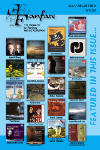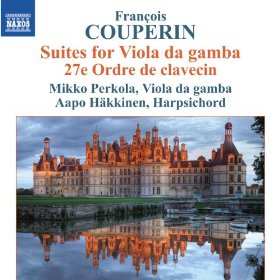Texte paru dans: / Appeared in: |
|||||||
|
Reviewer: Jerry
Dubins Here is an absolutely ravishing disc of music for viola da gamba and harpsichord by arguably one of the two greatest composers of the French Baroque, François Couperin (1668–1733), the other composer being Jean-Phillippe Rameau (1683–1764). Between 1713 and 1730, Couperin produced four volumes or books of keyboard suites containing a combined total between them of 27 suites, which he called “Ordres.” Here Aapo Häkkinen, one of my favorite harpsichordists (see review of his Goldberg Variations in 33:3), plays the concluding suite, the 27th Ordre from the fourth and final book, one of the shorter suites consisting of only four movements, on a beautiful 2008 Keith Hill copy of a 1769 harpsichord by Paris maker Pascal Taskin.
Two years earlier, in 1728, Couperin set to work composing the two suites for viola da gamba and harpsichord, the only two such entries in his catalog. Like his keyboard suites, the viola da gamba works also vary in number and stylization of movements. They are, however, more formalized than the keyboard suites, which are largely made up of pieces caractéristiques, pictorializing in music people, places, and things. In fact, the layouts of the two viola da gamba suites anticipate the da camera and da chiesa type sonata formats found in Bach’s Unaccompanied Violin Sonatas and Partitas.
The E-Minor Suite follows the da camera or partita pattern of dance movements—Allemande, Courante, Sarabande, Gavotte, and Gigue, enclosed within an opening Prélude and a closing six-minute-long Passacaille ou Chaconne. The A-Major Suite conforms to the da chiesa layout of four movements—slow, fast, slow, fast—with Couperin opting for a short second-movement titled Fuguète. While the third and fourth movements satisfy the slow, fast formal requirement, the composer can’t resist anthropomorphizing them with extra-musical titles, Pompe funèbre (“funeral director”) and La Chemise-blanche, which Keith Anderson’s program note suspects is a reference to something other than a white shirt, perhaps a popular song of the time. Incidentally, Anderson translates Pompe funèbre as “funeral procession,” but according to my French dictionary, the word for “procession” is procession or for a funeral, cortège. Pompe funèbre is translated as funeral director and undertaker as entrepreneur de pompes funèbres. It may be a minor point, but given Couperin’s inclination to paint musical portraits of actual people he knew, he might well have intended the movement as a character sketch of a funeral director with whom he was acquainted.
In any case, gambist Mikko Perkola performs the two suites on a 1998 Guy Harrison copy of a 1691 viola da gamba by Paris maker Michel Colichon. The six-stringed instrument pictured in the booklet is gorgeously vibrant and full-throated, yet at the same time, as played by Perkola, sweet of voice and translucent of tone. I could listen to this disc for hours on end. It’s absolutely and enthusiastically recommended. | |||||||
|
|||||||
|
|
|
||||||
|
Cliquez l'un ou l'autre
bouton pour découvrir bien d'autres critiques de CD |
|||||||




